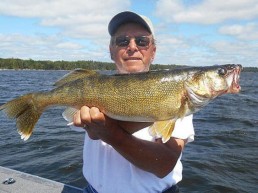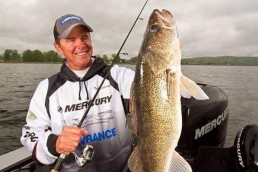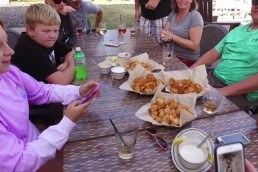Slip-bobber Secrets: Refine your Approach for more Walleyes
SHARE THIS POST
Fishing for walleyes is done with several approaches such as muskie fishing. There are several lures and techniques used and multiple methods. Using live bait is also very common. In this article, we are going to discuss the use of the slip bobber with live bait for the elusive walleye.
Throughout several Midwestern states, the walleye is a much sought-after gamefish, not only for their fine table fare but also for the challenge of catching them, which at certain times of the year can be very tricky. Using a 4- to 8-pound-test equivalent superline is important, in my opinion, because this line slips through the bobber with little or no resistance, the days of line twist have been over for years and years. Using a fluorocarbon leader is also good.
Using a leader is very critical to our success. There are times when we are slow drifting along a tapering drop from a long, extended point and the walleyes are four feet off the bottom. They are not always related just to the bottom, as we will discuss further in this article. This approach is best used on a little to no-wind situation when fishing a long, tapering underwater point (yes, you can use a lindy rig or bottom bouncer). We like the slip-bobber because we can put the bait directly in front of the fish without guessing where our bait is in conjunction with no abrupt movement such as jigging, casting and rigging creates.
Ok, so now what? Well, it’s easy. On most calm, still days, it’s sunny or close to it. The fish are spooky, as most species are during these conditions.
A smaller #1 colored Drop Shot hook is ideal for this situation. Just the hook is used; no other part of the drop shot configuration is used. The shape of this hook is critical to your high percentage of hook ups; we are at 90 percent. Try them; they work. The color of this hook can help in the amount of strikes you receive.
The weight system (for us) is as follows. It depends on wind conditions, depth, current, and if we are in trees or weeds. If we are working in water deeper than 10 feet or if we are in current, we like to place our weights about 12 inches apart so our bobber is just about 1-1/2 inches above the water. The deep fish cannot feel the bobber when pulled under the surface. If we are in current, the spacing of the weights will slow our drift.
Fishing in the weeds may require precision placement of the bobber, as the fish can be tightly grouped in a small area of the weeds, usually the thickest section. Sometimes adding additional color to your line helps create a strike. Adding different colored slipknots to the line, with some extra line sticking out from each side of the knots, will wiggle around and attract more strikes. This works.
The size of our slip-bobber depends on how much weight we are using; if we are using traditional slip-bobbers (4 inches tall), we like weighting them so the bobber is halfway under water. If we are fishing in windy conditions and drifting, we may switch to a tall, 10-inch pencil bobber. This bobber has much less wind resistance and moves slowly even when windy. However, it is difficult to cast.
Are you enjoying this post?
You can be among the first to get the latest info on where to go, what to use and how to use it!
When fishing deep rock bars, humps, woodpiles or deep flats, we again place our weights about 12 inches apart and use up to four or five at a time. By placing a bigger weight at the bottom and top, and smaller weights in the middle, the live bait will not entangle. The system drops down to the desired depth.
Using minnows works well for a slip bobber. We like using a larger chub minnow on the bobber. Most species of fish like a big meal especially if they do not have to chase after it. The slip-bobber works very, very well for this. Also, the bigger minnow continuously moves and swims around, attracting bigger game fish. Using a nightcrawler hooked onto the slip bobber works well when drifting the mud flats or on the bottom of the weed beds.
Leeches are very productive in many locations. When we are fishing deep or shallow wood structure, they can be bumped along the branches. The leech does not pull free from the hook. When on top of rock piles, they work well. The walleyes gorge themselves on leeches when they are utilizing this location. In fact, most locations are good for leeches. Slip bobbers work very well throughout the year, especially during the warmer water temperatures. Pulling plastic baits under a slip-bobber works well also and again, during warmer water temperatures.
Setting up a slip-bobber rig is very simple. We start with a slipknot, which can be purchased at most sporting good stores or bait shops. This knot is pre-tied to a small section of a straw. You slide your line through the straw and push the pre-tied knot onto your line. Pull the two tag ends tight so the knot tightens to your line.
Slide the small piece of straw off and then slide your line into the top of a slip bobber and out the bottom of the slip bobber. Then tie your hook on and add some weight above your hook to pull the bait down. You simply slide the knot up or down the line to your desired depth you wish to fish, easy. Now let’s go get’em.
John Andrew is a fishing and tour guide in a wide area comprising Vilas, Oneida, and Iron counties, Wisconsin. He holds two world fishing records.
Contact: theanglerschoiceguideservice.com, johnandrew@centurytel.net, 715-892-3020.
MWO
SHARE THIS POST
Did you enjoy this post?
You can be among the first to get the latest info on where to go, what to use and how to use it!
John Andrew
John Andrew is the owner/operator of The Anglers Choice Guide Service located in northern Wisconsin. He may be reached at 715-892-3020, 715-686-2012 or johnandrew@centurytel.net or theanglerschoiceguideservice.com.



